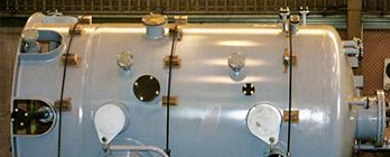
- (03) 5909 8218
- enquiry@fusionweld.com.au
A Guide to Safe Installation of Gas Storage Vessels
April 7, 2015

There are a number of deciding factors, codes and standards that dominate the design and fabrication of pressurized vessels. In keeping with this stringent suite of documented regulations, the dispatch of the product to its installation site is equally governed by lawful directives. Browse to the AS1210, AS4332, to all of the other relevant codes and standards to get an idea of just how many regulations must be adhered to in order to certify the tank for the actual hands-on installation procedure. There's an intimidating list of these guidelines, but every one of them must be satisfied when building a safe operational space in a modern engineering environment. Note, the above regulations have been snipped from Australian codes, so please refer to your own national guidelines unless your product is being shipped to Australia.
The management of the installation site in question addresses the safety concerns of the gas storage vessel. There's the interface between the vessel and extraneous connections to consider, the expert connection to service pipework, valves and fittings, and any associated instrumentation. Also, perhaps more importantly, the location and orientation of the tank must be properly established. Is this an above ground or underground project? What ancillary equipment is entering the boundaries of the area? The guidelines are in place to service both the domestic gas storage and industrial sector, but emphasis is purposefully placed on heavy-duty vessels, the storage tanks that contain large volumes of gas as conveyed from offshore oil rigs or natural gas refineries. These facilities form large stations where ranks of vessels stand to attention, presenting a hazard that's potentially far more life threatening than a comparable domestic facility.
Slipping away from Australian regulations and codes defined by overseas authorities, the provision of all interconnecting spooling alongside the gas storage vessel acts as an installation equalizer, ensuring the pipes and associated processing equipment are fabricated to the same exacting standard as the gas storage vessel. Assuming the installation project is adhering to Australian engineering standards and pre-assembly isn't a given, we turn to another governing standard, the services of AS3892 where the uniformity of pressure vessel installation is illustrated in mandatory terms. This legislature and others like it are in place to cover installation issues. Grading of the site is detailed in these documents, as is the compacting of soil and the provision of a sound foundation for the vessel, meaning concrete groundwork and a support plinth is already in place and waiting.
Mounted on each respective foundation point, bolted, welded and sealed in place, the engineer oversees the installation of the gas storage vessel and the subsequent attachment of ancillary components, then moves on to the commissioning stage of this formidable project.
Contact Details
Fusion - Weld Engineering Pty Ltd
ABN 98 068 987619
1865 Frankston Flinders Road,
Hastings, VIC 3915
Ph: (03) 5909 8218
Optimized by NetwizardSEO.com.au
Recent Posts
- Compressed Hydrogen Storage Vessels: Material Selection, Design & Australian Standards
- Welding QA/QC in Oil & Gas Pressure Vessel Fabrication – Ensuring Code Compliance
- AS1210 vs ASME VIII Pressure Vessel Code: Key Differences for Australian Projects
- Mitigating Hydrogen-Induced Cracking in Pressure Vessels: Engineering and Material Strategies
- Storage Tank Solutions Australia: Field-Erected, Prefabricated & Self-Bunded Explained
- Reducing Environmental Risks: Self-Bunded Tanks in Australian Oil & Gas Operations
- Precision in Production: How Pressure Vessels Are Manufactured for Industrial Safety
- Shell & Tube Heat Exchangers: Improve Thermal Control & Energy Recovery in Petrochemical & Pharmaceutical Plants
- In-Service Inspection for Compressed Air Receivers for Power Plant Shutdown Prevention
- Power Plant Pipe Spooling Fabrication – Get Rapid, Code-Compliant Spools Ready for Installation
- Field Erected Tanks: Safe, Reliable On-Site Fuel Storage Solutions in Australia
- Custom Pressure Vessel Fabrication for Flammable Gases
Posts 2025
- Compressed Hydrogen Storage Vessels: Material Selection, Design & Australian Standards
- Welding QA/QC in Oil & Gas Pressure Vessel Fabrication – Ensuring Code Compliance
- View all articles…
Posts 2024
- Large Process Vessels: Optimising the Design for Maximum Efficiency [2025]
- Pressure Equipment Management System Installation: Detect Equipment Faults Early
- View all articles…
Posts 2023
- Pressure Piping System Inspection: A Gift of Safety for the Holidays
- Deaerator Inspections by Fusion-Weld Engineering and How They Reduce System Downtime
- View all articles…
Posts 2022
- How Fusion Weld Keeps Up With AS-NZS ISO 9001:2008 Standard
- Boiler Equipment Safety Inspection During the Summer Season
- View all articles…
Posts 2021
- Avoid These Factors and Practices that Contribute to Sealing Damage in Pressure Vessels
- Do's And Don'ts Of Industrial Boiler Inspection And Maintenance From Fusion-Weld
- View all articles…
Posts 2020
- What are the Risks and Hazards Involved in Pressure Vessel Equipment?
- How to Know if Your Pressure Equipment Needs Repair or Replacement?
- View all articles…
Posts 2019
- Factors that Contribute to Pressure Vessel Failure
- Pressure Vessel Regulations in Australia: What are the Mandatory Requirements?
- View all articles…
Posts 2018
- Pros and Cons of Spherical vs. Cylindrical Pressure Vessels
- What are the Different Hazard Levels in Pressure Vessels?
- View all articles…
Posts 2017
- Transportable Pressure Vessels: The Importance of Inspection and Safety Checks
- Fracture Mechanics and Stress Analysis of Cracks in Pressure Vessels
- View all articles…
Posts 2016
Posts 2015
- What Are Deaerators & Feedwater Vessels?
- Precautions and Safety for Compressed Air Receiver Vessels
- View all articles…
Posts 2014
- Demonstrating In-process Inspection Procedures
- Static Grounding Practices and Standards
- View all articles…